

INTRODUCTION TO SAILBOAT DESIGN: A TECHNICAL EXPLORATION
Sailboat design is a complex and fascinating field that blends engineering, hydrodynamics, and aesthetics to create vessels that harness the power of the wind for propulsion. In this highly technical article, we will delve into the key aspects of sailboat design, from methodology to evaluation.
1) Design Methodology
Designing a sailboat is a meticulous process that begins with defining the vessel’s purpose and performance goals. It involves understanding the intended use, whether it’s racing, cruising, or a combination of both. Sailboat designers must also consider regulatory requirements and safety standards.
Once the design objectives are established, naval architects employ various computational tools and simulations to create a preliminary design. These tools help in predicting the boat’s performance characteristics and optimizing its geometry.
Design methodology also encompasses market research to understand current trends and customer preferences. This information is critical for creating a sailboat that appeals to potential buyers.
2) Hull Design
The hull is the heart of any sailboat. Its shape determines how the boat interacts with the water. Hull design encompasses the choice of hull form, its dimensions, and the material used. The hull’s shape affects its hydrodynamic performance, stability, and overall handling.
For example, a narrow hull design with a deep V-shape is ideal for speed, while a wider, flatter hull provides stability for cruising. The choice of materials, such as fiberglass or aluminum, impacts the boat’s weight and durability.
The hull design is a balance between achieving efficient hydrodynamics and providing interior space for accommodations. As a designer, finding this equilibrium is a constant challenge.
3) Keel & Rudder Design
The keel and rudder are critical components of a sailboat’s underwater structure. The keel provides stability by preventing the boat from tipping over, while the rudder controls its direction. Keel design involves selecting the keel type (fin, bulb, or wing) and optimizing its shape for maximum hydrodynamic efficiency.
Rudder’s design focuses on ensuring precise control and maneuverability. Both components must be carefully integrated into the hull’s design to maintain balance and performance.
Keel and rudder design can be particularly challenging because they influence the boat’s behavior in different ways. A well-designed keel adds stability but also increases draft, limiting where the boat can sail. Rudder design must account for both responsiveness and the risk of stalling at high speeds.
4) Sail & Rig Design
Sail and rig design play a pivotal role in harnessing wind power. Sail choice, size, and shape are tailored to the boat’s intended use and performance goals. Modern sail materials like carbon fiber offer lightweight and durable options.
The rig design involves selecting the type of mast (single or multiple), rigging configuration, and mast height. These choices influence the sailboat’s stability, maneuverability, and ability to handle varying wind conditions.
Balancing the sails and rig for optimal performance is a meticulous task. The sail plan should be designed to efficiently convert wind energy into forward motion while allowing for easy adjustments to adapt to changing conditions.
5) Balance
Balancing a sailboat is crucial for its performance and safety. Achieving the right balance involves a delicate interplay between the hull, keel, rudder, and sail plan. Proper balance ensures the boat remains stable and responds predictably to helm inputs, even in changing wind conditions.
Balance is not a static concept but something that evolves as the boat sails in different wind and sea conditions. Designers must anticipate how changes in load, wind angle, and sail trim will affect the boat’s balance.
Achieving balance is both an art and a science, and it often requires iterative adjustments during the design and testing phases to achieve optimal results.
6) Propulsion
While sailboats primarily rely on wind propulsion, auxiliary propulsion systems like engines are essential for maneuvering in harbors or during calm conditions. Integrating propulsion systems seamlessly into the boat’s design requires careful consideration of engine placement, fuel storage, and exhaust systems.
The choice of propulsion system, whether it’s a traditional diesel engine or a more eco-friendly electric motor, also impacts the boat’s weight distribution and overall performance.
7) Scantling
Scantling refers to the selection of structural components and their dimensions to ensure the boat’s strength and integrity. It involves determining the appropriate thickness of the hull, deck, and other structural elements to withstand the stresses encountered at sea.
Scantling is a critical aspect of sailboat design, as it directly relates to safety. A well-designed boat must be able to withstand the forces exerted on it by waves, wind, and other environmental factors.
8) Stability
Stability is a critical safety factor in sailboat design. Both upright hydrostatics and large-angle stability must be carefully assessed and optimized. This involves evaluating the boat’s center of gravity, ballast, and hull shape.
Achieving the right balance between initial stability, which provides comfort to passengers, and ultimate stability, which ensures safety in adverse conditions, is a delicate task. Designers often use stability curves and computer simulations to fine-tune these characteristics.
9) Layout
The layout of a sailboat’s interior and deck spaces is a blend of functionality and comfort. Designers must consider the ergonomics of living and working aboard the vessel, including cabin layout, galley design, and storage solutions. The deck layout influences crew movements and sail handling.
Layout design also extends to considerations like ventilation, lighting, and noise control. Sailboats are unique in that they must provide both comfortable living spaces and efficient workspaces for handling sails and navigation.
10) Design Evaluation
The final phase of sailboat design involves rigorous evaluation and testing. Computational fluid dynamics (CFD) simulations, tank testing, and real-world sea trials help validate the design’s performance predictions. Any necessary adjustments are made to fine-tune the vessel’s behavior on the water.
The evaluation phase is where the theoretical aspects of design meet the practical realities of the sea. It’s a crucial step in ensuring that the sailboat not only meets but exceeds its performance and safety expectations.
Conclusion:
In conclusion, sailboat design is a highly technical field that requires a deep understanding of hydrodynamics, engineering principles, and materials science. Naval architects and yacht designers meticulously navigate through the intricacies of hull design, keel and rudder configuration, sail and rig design, balance, propulsion, scantling, stability, layout, and design evaluation to create vessels that excel in both form and function. The harmonious integration of these elements results in sailboats that are not just seaworthy but also a joy to sail, and this process is a testament to the art and science of sailboat design.
Click here to read about “ HARNESSING THE POWER OF ARTIFICIAL INTELLIGENCE IN BOAT DESIGN “
Follow my Linkedin Newsletter here: “LinkedIn Newsletter”
0 comments Leave a reply
Save my name, email, and website in this browser for the next time I comment.
Recent Posts
- THE CHALLENGES Of SMALL CRAFT DESIGN COMPARED TO LARGER VESSELS
- UNDERSTANDING ROYALTY AGREEMENTS & DESIGN OWNERSHIP IN BOAT DESIGN
- FREQUENTLY ASKED QUESTIONS TO A BOAT DESIGNER: A COMPILATION
- ADVANTAGES OF HDPE COLLAR OVER REGULAR RIB
- HDPE’S EXCLUSIVE FEATURES DISTINCT FROM TRADITIONAL BOAT MATERIALS
Recent Comments
- Casey Lim on HDPE BOAT PLANS
- BRYN BONGBONG on HDPE BOAT PLANS
- Keith on HDPE BOAT PLANS
- Daniel Desauriers on WHY HDPE BOATS?
- November 2023
- October 2023
- February 2023
- January 2023
- September 2022
- January 2021
- ARTIFICIAL INTELLIGENCE
- boatbuilder
- BOAT CONSTRUCTION TECHNIQUES
- BOAT DESIGN COST
- boatdesign process
- CAREER PATHWAYS
- COMMERCIAL BOATS
- conventional boats
- custom boat
- DESIGN ADMINISTRATION
- DESIGN SPIRAL
- EXTREME CONDITIONS
- Freelance advantage
- freelance boat designer
- FRP Boat without Mold
- HDPE Collar
- INDIA'S MARITIME
- INVENTORY MANAGEMENT
- ISO STANDARDS
- Mass Production
- Monhull vs Catamaran
- Naval Architect
- Naval Architecture
- PLANING HULL
- Project Management
- Proven Hull
- PSYCHOLOGY OF BOAT DESIGN
- QUALITY CONTROL
- RECREATIONAL BOATS
- ROYALTY AGREEMENTS
- SANDWICH VS SINGLE SKIN
- SOLOPRENEUR
- YACHT DESIGN COURSE
Academia.edu no longer supports Internet Explorer.
To browse Academia.edu and the wider internet faster and more securely, please take a few seconds to upgrade your browser .
Enter the email address you signed up with and we'll email you a reset link.
- We're Hiring!
- Help Center

Sailboat Mast Design

The following is meant to be a review of sailboat mast design methods and their practical application. In the first portion, the Euler‐Bernoulli beam theory, the P‐Δ method, Skene’s method and the Nordic Boat Standard are summarised and evaluated as design methods for masts. It was found that the Nordic Boat Standard represents the state of the art available in the public domain. In the second portion, the practical case of the Ultimate 20 racing yacht is reviewed. The Ultimate 20 has shown a tendency for the mast failing by buckling at a stress concentration on the bottom of the mast, and several solutions have been brought forward to solve this issue. In order to quantitatively establish which configuration is best, this boat’s mast was modelled according to Euler‐Bernoulli beam theory and practically tested using strain gauges. The results of both the mathematical model and the practical testing show consistent results and trends. It was found that the best single solution to reduce the chances of mast failure was the addition of baby stays.
Related Papers
Journal of Wind Engineering and Industrial Aerodynamics
Frédéric Hauville , Benoit Augier , Patrick Bot
adeel tariq
Mandate Concern for the structural design of sailing yachts and other craft. Consideration shall be given to the materials selection, fabrication techniques and design procedures for yacht hull, rig and appendage structures. The role of standards, safety and reliability in the design and production processes should be addressed. Attention should be given to fluid-structure interaction effects on hulls, rigs and appendages and their influence on structural design.
Leigh Sutherland
Nattapojn Sriwichian
General Definition for Specialized Maritime vocabulary
Robert H Pritchett III
CECILIA COSTANZI
glossario nautico
Akbar Antoni
diccionario nautico
Sebastian Romero Solis
a | b | c | d | e | f | g | h | i | j | k | l | m | n | o | p | q | r | s | t | u | v | y | z subir A bordo = on board A bordo = Aboard A favor del viento = Off the wind a la deriva = adrift a media driza, a media asta = half-mast high A plan = Sitting down into the boat A popa = Backwards A popa = astern A popa = aft A popa = abaft A proa = Ahead / forward A sotavento = Leeward A sotavento = downwind A un largo = When reaching A un largo = reaching Abaniqueo = Pumping abarloarse = to lie alongside Abatir = To bear away Abatir = To make lee Abatir en la racha = To bear off in a puff abertura = telltale holes abertura de inspección = handhole abertura de la cámara de humo de la caldera = fiddley opening abertura de mano = handhole abeto = fir abocinado = flared Abordaje = Collision Abordar = touch abordar = collide abordar un buque = to board a vessel abordar un buque = board a vessel abrasión = abrasion abrazadera = clamp
RELATED PAPERS
Leonam L S Guimaraes
anastasios batsoulis
Julian Whitewright
DANILO FABBRONI
Kroum Batchvarov
Ignacio López Almenar
Russell Beale
Zeynep Tecimen
Henrik Pohl
Ahmad Rosidin
Ocean Engineering
Dario Motta
Patrick Bot
Joseph Kilby Sanggalang
Julio García
Benjamin Ioset
Azlam Muhammad
Nathan Helfman, PhD
Eric Staples , Alessandro Ghidoni , Luca Belfioretti
Frédéric Hauville , Dario Motta , Patrick Bot
International Journal of Nautical Archaeology
Nick Burningham
In Myos Hormos - Quseir al-Qadim. Roman and Islamic ports on the Red Sea 2: Finds from the 1999–2003 excavations, D. P. S. Peacock and L. Blue (eds), 179–210. BAR International Series 2286. Oxford: Archaeopress.
Ross I Thomas
Richard Flay
Indonesia Circle
Horst Liebner
Yusuke Tahara , Yutaka Masuyama
Ravi Gandhi
The Mariner’s Mirror
Roi Porat , Silvia Rozenberg
David Dixon
marianne George
Mark E . Polzer
RELATED TOPICS
- We're Hiring!
- Help Center
- Find new research papers in:
- Health Sciences
- Earth Sciences
- Cognitive Science
- Mathematics
- Computer Science
- Academia ©2024
- Types of Sailboats
- Parts of a Sailboat
- Cruising Boats
- Small Sailboats
- Design Basics
- Sailboats under 30'
- Sailboats 30'-35
- Sailboats 35'-40'
- Sailboats 40'-45'
- Sailboats 45'-50'
- Sailboats 50'-55'
- Sailboats over 55'
- Masts & Spars
- Knots, Bends & Hitches
- The 12v Energy Equation
- Electronics & Instrumentation
- Build Your Own Boat
- Buying a Used Boat
- Choosing Accessories
- Living on a Boat
- Cruising Offshore
- Sailing in the Caribbean
- Anchoring Skills
- Sailing Authors & Their Writings
- Mary's Journal
- Nautical Terms
- Cruising Sailboats for Sale
- List your Boat for Sale Here!
- Used Sailing Equipment for Sale
- Sell Your Unwanted Gear
- Sailing eBooks: Download them here!
- Your Sailboats
- Your Sailing Stories
- Your Fishing Stories
- Advertising
- What's New?
- Chartering a Sailboat
- Sailboat Design Ratios
Calculating Sailboat Design Ratios
Without having to wrestle with the mathematics.
Not only do the Sailboat Design Ratios tell us a great deal about a cruising boat's performance and handling characteristics, they also enable us to make objective comparisons between individual designs.
Here are the five main ones in common use by yacht designers and the formulae from which they are derived.
Five Key Sailboat Design Ratios:
The displacement/length ratio.
D/L Ratio = D/(0.01L) 3
Where D is the boat displacement in tons (1 ton = 2,240lb), and L is the waterline length in feet.
The Sail Area/Displacement Ratio
SA/D = SA/D 0.67
Where SA is sail area in square feet, and D is displacement in cubic feet.
The Ballast Ratio
BR = (B/D) x 100
Where B is ballast in lbs, and D is displacement in lbs.
The Capsize Screening Formula
CSF = 3 √(Bm/D)
Where Bm is the maximum beam in feet, and D is displacement in cubic feet.
The Comfort Ratio
CR = D/[0.65 x (0.7L 1 +0.3L 2 ) x Bm 1.33 ]
Where D is displacement in pounds, L 1 is waterline length in feet and L 2 is length overall in feet, and Bm is the maximum beam in feet.
Problem is, can you always trust the ratios published by the manufacturers? The answer, sadly, is "no".
So when you think you're comparing like-for-like, you may not be.
But let's be generous, it's not always an intentional deceit - there are two main parameters where ambitious data can lead to misleading Design Ratios. These are found in the manufacturers' published data for displacement and sail area .
In almost all yacht manufacturers' published data, displacement is quoted as the ‘light ship’ or unladen weight displacement.
This is unrealistic, as the laden weight of a fully equipped cruising boat is much higher.
As displacement is a key parameter in all of the Design Ratios, the laden weight should be taken account of when comparing one boat’s ratios with those of another.
Published SA/D ratios can similarly be misleading as some manufacturers, keen to maximize their vessels’ apparent performance, quote the actual sail areas which could be based on a deck-sweeping 150% genoa. On paper this would compare unjustly well against a competitor’s boat that has the ratio calculated on the basis of a working jib.
Making an objective comparison between two such sets of SA/D ratios would be impossible.
An objective comparison can only be made if sail areas are calculated on the same basis using the J, I, P and E measurements as set out in the above sketch.
So now to the point...
What we have here is our Interactive S ailboat Design Ratio Calculator , which does all the calculations for you instantly and avoids all the pitfalls described above. The pic below is where you would enter the dimensional data on the downloaded Design Ratio Calculator :
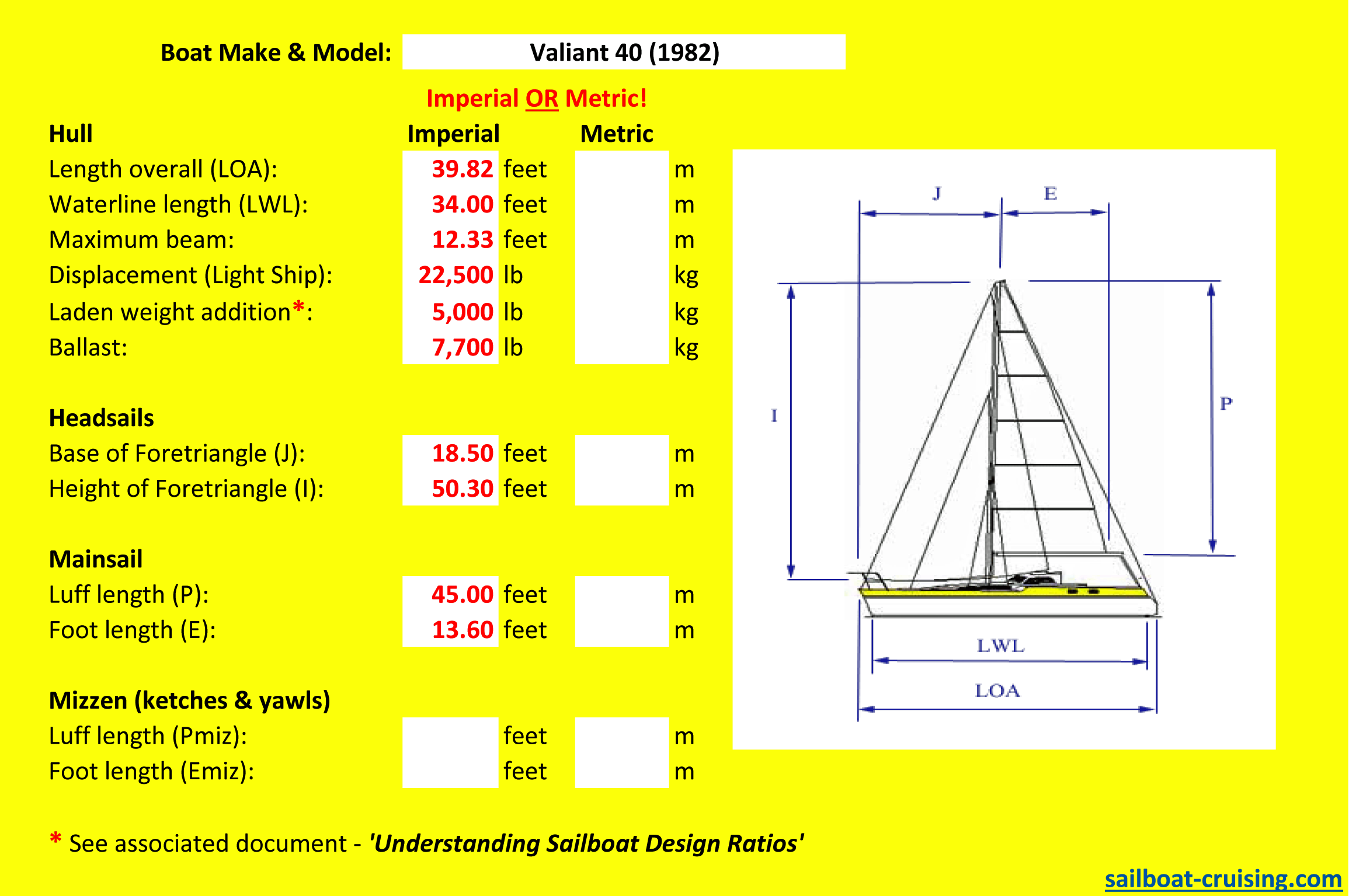
The following pic shows the Design Ratios which are automatically calculated in the blink of an eye!
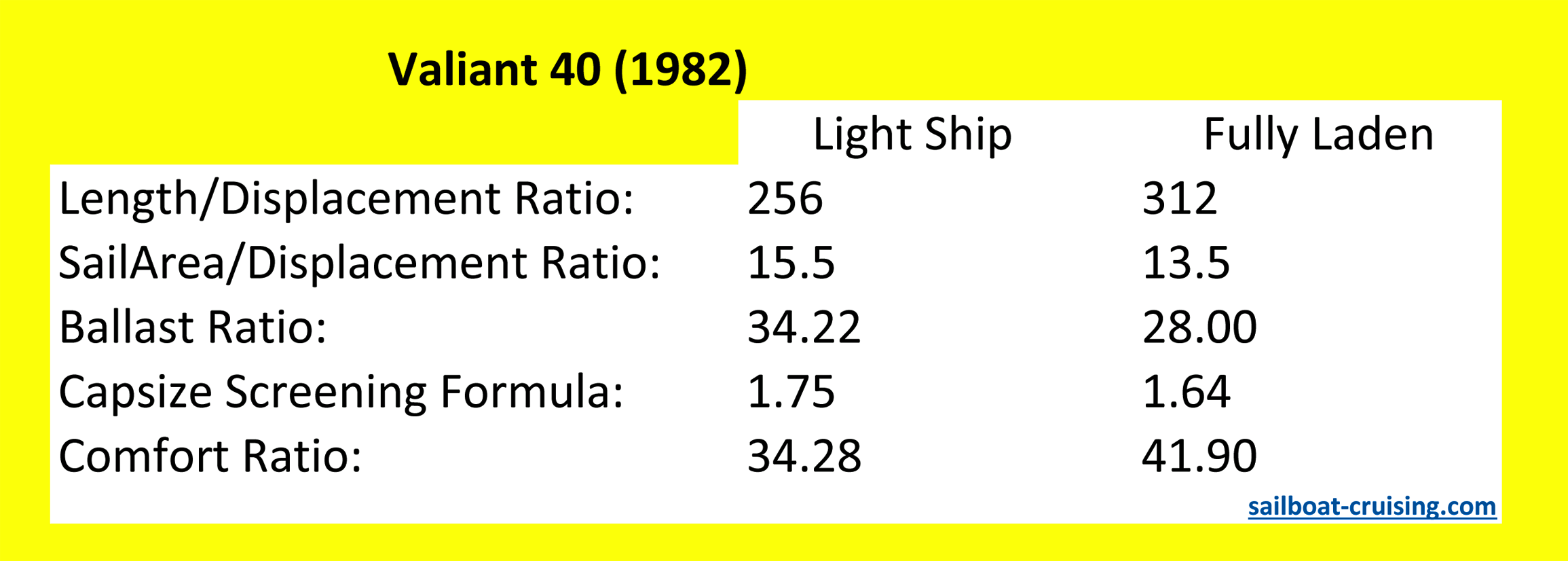
Download the Sailboat Design Ratio Calculator...
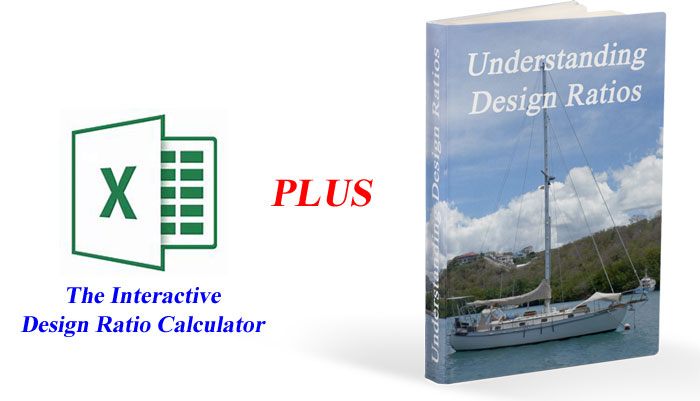
The Interactive Sailboat Design Ratio Calculator is accompanied by a free eBooklet 'Understanding Sailboat Design Ratios' which will help you make sense of the numbers.
Our 'Sailboat Design Ratio Calculator' takes all the hard work out of calculating the numbers and will provide a valuable insight into a sailboat's performance and handling characteristics.
We make a small charge of $4.99 for this useful tool as a contribution towards the costs of keeping this website afloat.
This Sailboat Design Ratio Calculator and eBooklet comes with a No-Quibble Guarantee!
Sailboat-Cruising.com's Promise to You:
"I'm so sure that you'll be absolutely delighted with your purchase that I'll refund in full the price you paid if you're dissatisfied in any way" , promises
Dick McClary , Owner/Creator of sailboat-cruising.com and member of:
- The Yachting Journalists Association, and
- The Ocean Cruising Club.
So what are you waiting for?
Recent Articles
Westerly Oceanranger 38 for sale
May 19, 24 04:09 AM

Hunter Passage 450 for sale
May 18, 24 03:46 AM
Used Sailing Equipment For Sale
May 15, 24 02:04 AM
Copyright © 2024 Dick McClary Sailboat-Cruising.com

- For Sale/Wanted
- Readers Tips
- Your Yarns.
- Restoration
- Miscellaneous
- DIY Boat Yards
- Boat Building
- Cabin Cruisers
- Free Boat Plans
- Begin Boating
- Boating Terms
- Ropes and Rigs
- Just for Fun
- Celestial Navigation
- Passage Planning
- VHF Marine Radio
- Diagonal Scale
Sailboat Plans
Free Sailboat Plans
A selection of some of the Free Sailboat Plans (pdf) that were published in magazines such as “Popular Mechanics”, "Popular Science" and the "Boat Builder Handbook".
If you need help with lofting out the plans click here for an article here which should help.
- Open Dayboats/Dinghys
- Rowing Boats
Open/Dayboat, Free Sailboat Plans
Everyone who digs boating has heard of the Hobie Cat, the sleek little catamaran that burst on the scene and captured the attention of all the fast-action sailors.
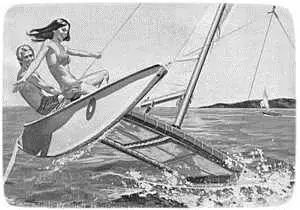
Marked by asymmetrical hulls and special trampoline supports, the Hobie can reach speeds above 20 mph and perform with a rare agility.
But it has one drawback.
It costs mucho dinero.
Thus, we introduce the Hobby Kat, sailboat plans, a build-it-yourself version of the “Hobie” that should cost from half to a third of the commercial version. If you have the moola, of course, go for a Hobie and have the time of your life on the water.
If not, try our Hobby
The homebuilt is not quite the same.
But she sails sweetly and fast—qualities which have made the “Hobie” popular
Even in a light air she’ll slip through the water at a fast clip.
She has no centreboards, leeboards or keel, and needs none.
The inside of each hull has built-in lift, like an airplane wing, so that as the boat heels and one hull digs in the boat is pulled back to windward.
Click Here for the Plans
She can run in very shallow water and the rudders kick up for beaching.
You can carry her on a trailer or even disassemble her.
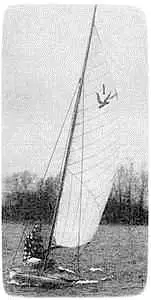
Many a “stink pot” addict will take a second look at Tern because she planes in modest breezes, is easy to handle, and her streamlined prow arid pod-shaped, “inland scow” type hull offer slight water resistance. Then too, there’s a charm about the tiller of a sailer that’s not matched by the wheel of a motor-powered boat. Part of it is the challenge of making the most of nature’s free-wheeling breezes. Even with her 72sq.ft of sail, this Free Sailboat Plan is remarkably stable, and packs as many as four persons aboard
For thousands of inland lakes, Tern is the answer to sailing water sport, she is rugged and easy to launch
And she’s remarkably easy to build.
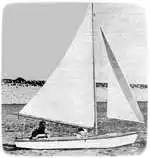
Falcon is a small, speedy, sporty sailboat which handles well. Tests on the original Falcon showed that she could easily out-distance boats of comparable size such as the one design class Snipe and Comet sailers.
And she will pace neck and neck with 18 footers with considerably greater sail spread.
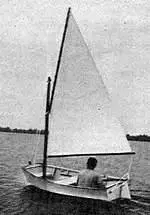
This strong, beamy, eight-foot pram may be sailed either cat-rigged or sloop-rigged.
The dagger-board may be adjusted forward to balance the helm when sailing with the addition of a jib sail.
Oars or a small outboard motor may also be used to power this versatile Free Sailboat Plans.
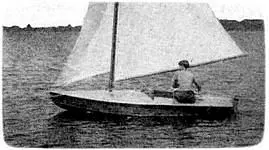
Dart” is a small two or three person sailing craft, designed for use on protected waters such as bays. lakes, rivers or wherever sheltered waters are found. Its construction will repay the builder handsomely and provide a fast sailing craft, light in weight, easily transportable and cheap to construct with all difficult joinery eliminated
It provides thrilling and economical sport.
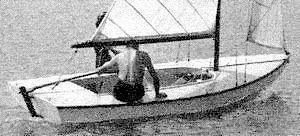
The 'Crescent', designed by C. T. Allen, is the ideal sailboat for day sailing on a small lake, river, or protected waters of a bay.
Centreboard design (Fig. 2) reduces Crescent's draft, so Shallow is not a problem.
Its broad beam of over 5½ft. makes it an ideal family boat because there is room for a cockpit large enough to accommodate four adults or two adults and three kids, and side and forward decks big enough to stretch out on when sun bathing.
"Jewel" is a 16' Crescent Sailboat being built by Mike Allen from the free sailboat plans by C.T .Allen in the 1958 "Boat Builders Handbook". And what a superb job Mike is doing check out his photos here .
Click Here for the Free version of the Plans
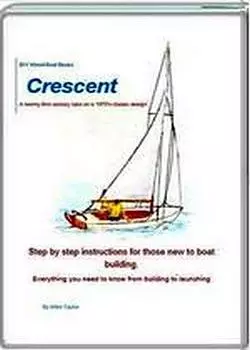
Sailing enthusiasts and backyard boat builders are not likely to find free boat plans for a sailing pram that can be built faster, lighter, stronger, or less expensively than Graefin-10. Two men can begin work on a Friday evening and have a smart, lively 10-ft. 85-pound sailboat in the water by Sunday evening (it’s been done).
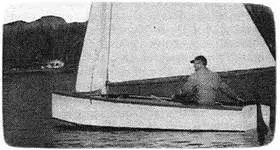
Zephyr Is a refinement of a type of boat developed by the English for use in the rough open waters of the English Channel. Not only is it fast under sail, but it can stand up under punishment. And it’s light enough to be easily loaded atop an auto or light trailer.
Breeze-Baby
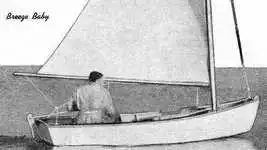
Skimming off a brisk wind or with the wind abeam, Breeze-Baby actually planes with one person aboard. Despite her rowboat lines that make her easy to build, she handles easily under her simple sail, an ideal first boat. Simple lines are adapted to plywood construction that’s strong, light and that keeps Breeze-Baby’s bilges dry
You can take her with you atop your car or on a lightweight trailer for summer fun wherever you vacation or get in a week-end’s sailing.
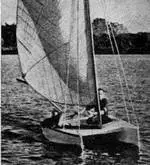
Cat’s Paw is easy to build because of the straight-sided hulls. The sheer line is flat and that simplifies building the form. Bow and stern are straight, so there’s no cockeyed bevel to fit and fuss with
She Is an Ideal boat to learn or practice sailing in because she will forgive so many mistakes.
Cabin Cruiser, Free Sailboat Plans
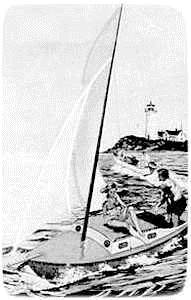
Previous posts
See What Others Have Posted

Recent Articles
Automatic Identification System AIS
May 18, 24 05:01 AM

- Boat Plan Books
- Boatbuilding Tips
- Glass Cloth
- Stitch and Glue
- Strip Plank
You might like these

Plywood and Veneer Guide for Marine use.
A guide to plywood for boat building and why you should use the best marine grade you can afford.
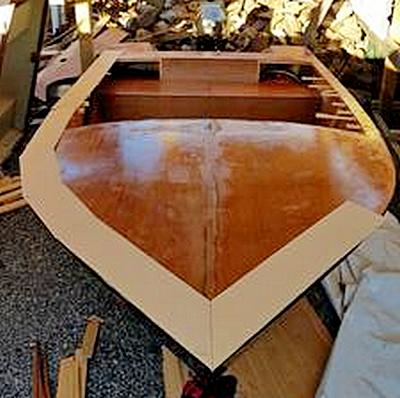
DIY Woodboat Building Questions
Woodboat building questions a Forum for wooden boat building, plans, lumber, caulking compounds and other boat building problems.

Boat Books for Wooden Boat Builders
Boat Books a series of boat books based on some of the 1960's, classic, Free Boat Plans that were published in magazines such as "Popular Mechanics", "Popular Science" and the "Boat Builder Handbook".

Build a Boat, tips for the DIY Wooden Boat Builder.
How to Build a Boat, Wooden Boat Building methods for the DIY, backyard, self-builders explained, carvel, lapstrake and plywood
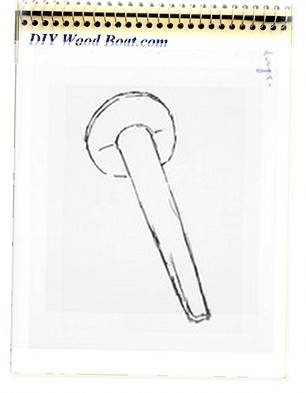
Clench Nails, Fastening for Small Wooden Boats.
How to use Clench Nails, these provide a fast reliable method for fastening small wooden boats.

Wood Screws for Boat Building and Repair.
Wood Screws are the most widely used and versatile fasteners used on wooden boats. Which type to use and how to use them
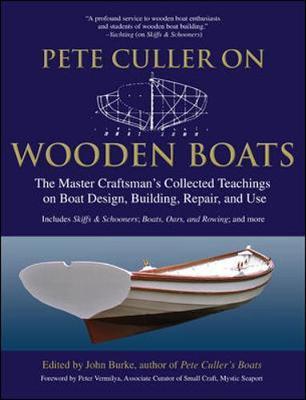
Timber, Lumber for Boat Building.
A brief description of the most common Timber used for building Wooden Boats how to choose wood for your project boat

Timber Properties
A brief guide to timber properties and wood, characteristics such as strength, stiffness and elasticity for choosing lumber for wooden boat building and restoration.
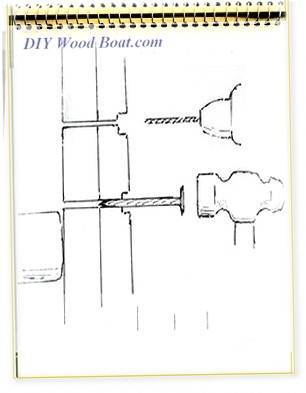
Rivets and Copper Rove Wood Boat Fastenings.
How to use Copper Rivets and Roves construction guide to fasteners on your wooden boat.

Ring Nails for Marine Fastening.
Ring Nails sometimes call Gripfast or ring shank, silicon bronze boat nails are renowned for their holding power. but how to get them out?

Free Motorboat Plans
Free Motorboat Plans for the backyard home builder, build your own speed boat, cabin cruiser, runabout or utility boat using these simple plywood designs.
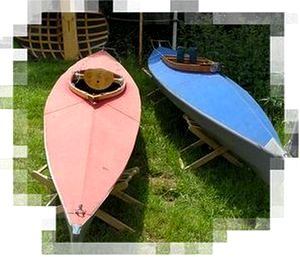
Wooden Boat Kits.
Wooden boat building is easy and inexpensive with wooden boat kits. From row boats and kayaks to sailing cruisers, boat to be proud of

Supplies for Wooden Boat building and Maintenance
Supplies for Wooden Boat Building and restoration, how to choose the materials and marine chandlery for your project.

DIY Woodboat Questions
Woodboat questions and answers forum for all Wooden Boat owners, advice and opinions on all aspects of wooden boat building, restoration and maintenance.

Small Boats, Made of Wood
What Everybody ought to know about building Small Boats, guidance and tips for self-building or restoring.
Wooden Boat Events 2024
Apr 14, 24 05:15 AM
14’ 1956 Chris Craft, side rail how should it be attached?
Apr 12, 24 03:38 AM
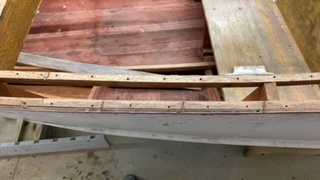
Woodboat Restoration questions forum
Woodboat restoration questions Forum, get advice about your Wooden Boat problems in a free, no frills, no need to sign up forum

Epoxy Resin for DIY Wooden Boat Building.
A guide to the epoxy resins and sustainable enrtopy resins to use when building wooden boats with marine plywood.

Wood Rot Repair and Treatment
Wood rot in wooden boats, how to treat, repair and replace rotten timbers in a wooden boat
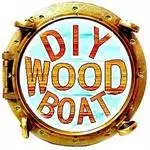
Privacy Policy
Advertising Policy
Cookie Policy

I am perfectly aware that the majority of Wooden Boat aficionados are sensible folk. However, I need to point out that I am an amateur wooden boat enthusiast simply writing in order to try to help other amateur wooden boat enthusiasts. And while I take every care to ensure that the information in DIY Wood Boat.com is correct, anyone acting on the information on this website does so at their own risk.
RETURN TO HOME PAGE

IMAGES
VIDEO
COMMENTS
sailboat design; all that's needed is to interpret them in sailing terms. The axioms of fast sailing designs are: (1) increased sail plan area (horse- power) increases speed; (2) lighter- weight hulls and keels produce faster boats; and (3) efficiently designed hulls make the best use of the horse- power produced by a sail plan.
with explanations of the various design ratios, publishing one a week. I admit to having an ulterior motive. Many years ago, a client of mine informed me of his invention of what he called the S Number (S#), which is a way to rate the performance of all sailboats on a scale of 1 to 10 using the Sail Area/Displacement ratio (SA/D) and the
Fn = 0,45 - 0,8. The buttocks of boat should be straight and near horisontal (transom boat) or the boat must be light compared to length. Power of semi-displacement boat (similar to displacement): 3 P 64 F. n . P power (kW) displaceme nt (m.
Course Description. This subject teaches students, having an initial interest in sailing design, how to design good yachts. Topics covered include hydrostatics, transverse stability, and the incorporation of the design spiral into one's working methods. Computer aided design (CAD) is used to design the shapes of hulls, appendages ….
The layout of a sailboat's interior and deck spaces is a blend of functionality and comfort. Designers must consider the ergonomics of living and working aboard the vessel, including cabin layout, galley design, and storage solutions. The deck layout influences crew movements and sail handling.
When the hull design is complete, starting with a sailplan having a total sail area of 51 m2, and adjusting it up or down as necessary, design a sloop rig (main and jib) that gives a Dellenbaugh angle of 20 degrees based on total sail area. Use the method on page 52 of the text, with the center of effort of each sail at 40% of its height, but ...
CF design head for Internals factor (1.4) A area of profile (1.5) b breadth of profile (1.5) h height of profile (1.5 ... Fist part is scantling of the main frame for a sailing boat and in second part it has been performed the finite element analysis (FEM) of the structure. Scantling (main dimensions), for the yacht of 58 m in length has been ...
SAILING YACHT DESIGN. adeel tariq. Mandate Concern for the structural design of sailing yachts and other craft. Consideration shall be given to the materials selection, fabrication techniques and design procedures for yacht hull, rig and appendage structures. The role of standards, safety and reliability in the design and production processes ...
Brewer T. Ted Brewer Explains Sailboat Design, 1985 - Free ebook download as PDF File (.pdf), Text File (.txt) or read book online for free. Yacht design is the graceful and artistic merging of science and art into a single, pleasing form. With a keen eye for aesthetics and an engineer's crisp emphasis on precision, Ted Brewer guides you into the designer's world.Throughout the pages of ...
The boat design design parameters or as the individual's best first guess. A we explore here mayperform at around three times the speed design tree is bloomedalong best-first lines; boats of higher of the wind. This boat design effort orginated in support of performancereceive more attention from the system.
Fig. VI-5. The Aerodynamic Force developed by a jib breaks up into three tangent forces at the three points of the sail and whose direction is determined by the halyard, the clew and the tack. The tensions developed in the fabric break up into loads normal and parallel to the three sides of the sail.
shape of the sail at the midquarter point has an effect on the shape of the upper and lower quarter points. Second, the middle of the sail is the so called "sweet spot" designed to match the physical parameters of the boat and maximize performance. To design the sail, the first step is to
Picture yourself in a sailboat, wind in your face, sail full, cutting swiftly from point to point through the water. . Sailing can set you free on the water and provide hours of fun and recreation, but it also requires some basic knowledge and ex- perience. Sailing Made Simple will help you get onto the water quickly, safely, and fully prepared.
At last we can do our displacement estimation. In the next formula, 2 is for two hulls and 1025 is the density of sea water (kg/m3). Loaded displacement mass in kg's is: mLDC := 2 ⋅ BWL ⋅ LWL ⋅ Tc ⋅ Cp ⋅ Cm ⋅ 1025. mLDC = 7136. Length/displacement -ratio, LDR, is a tool to evaluate our loaded displacement value. 3.
Sailboat Mast Design LITERATURE REVIEW AND APPLICATION TO THE U20 CASE BY : ALEXANDRE BERGERON ( 3784293 ) THESIS SUPERVISOR : DR. NATALIE BADDOUR MCG 4100 THESIS DEPARTMENT OF MECHANICAL ENGINEERING UNIVERSITY OF OTTAWA APRIL 20TH, 2009 fABSTRACT The following is meant to be a review of sailboat mast design methods and their practical application.
ISSC Committee V.8: Sailing Yacht Design 441. Sailing yachts are also subjected to impact loadings arising from a large range of. possible impact events, from collisions with other craft or ...
boat builder, on his website https://hvartial.kapsi.fi/ [2]. This design provided the basis for construction, but extra ribbing, runners, and support material were added. 2.1 Side Pieces The first step in manufacturing the boat hull is transferring the profile of the side pieces to 3/8" plywood. These profiles can be seen in Figure 2-1.
Our 'Sailboat Design Ratio Calculator' takes all the hard work out of calculating the numbers andwill provide a valuable insight into a sailboat's performance and handling characteristics. We make a small charge of $4.99 for this useful tool as a contribution towards the costs of keeping this website afloat. ThisSailboat Design Ratio Calculator ...
Covers the history, design, building and sailing of the sharpie, a working sailboat from America's fishing industry past - a shallow draft boat which boasts speed, elegance, and simple construction all in one hull. More than a dozen designs from Bolger, Chapelle, Kunhardt, Munroe, and the author are included, ranging in size from 15' to 40'.
A selection of some of the Free Sailboat Plans (pdf) that were published in magazines such as "Popular Mechanics", "Popular Science" and the "Boat Builder Handbook". ... The original design was sailed some 6000 miles in all kinds of weather under all manner of conditions, and been out hundreds of miles from the coast line on the Gulf of ...
Multichine 37 S K - 11.16 m (36.6 ft) blue water cruising sailboat, lifting keel. Multichine 38 Spor t - 11.60 m (38.1 ft) performance cruising, blue water sailboat, lifting keel. Explorer 39 - 12.00 m (39.4 ft) blue water cruising sailboat, lifting keel. Aventura 40 - 12.27 m (40.3 ft) blue water cruising sailboat, classic style ...
COMPLETE BOAT PLANS & CUTTING FILES. This design features a modern un-broken sheerline with a deck salon a feature of this boat. With 100% accurate CUTTING FILES, complete assembly plans, engineering drawings and printed building instructions this is a larger sailboat that you can build in minimum hours. The pilot house version offers shelter ...